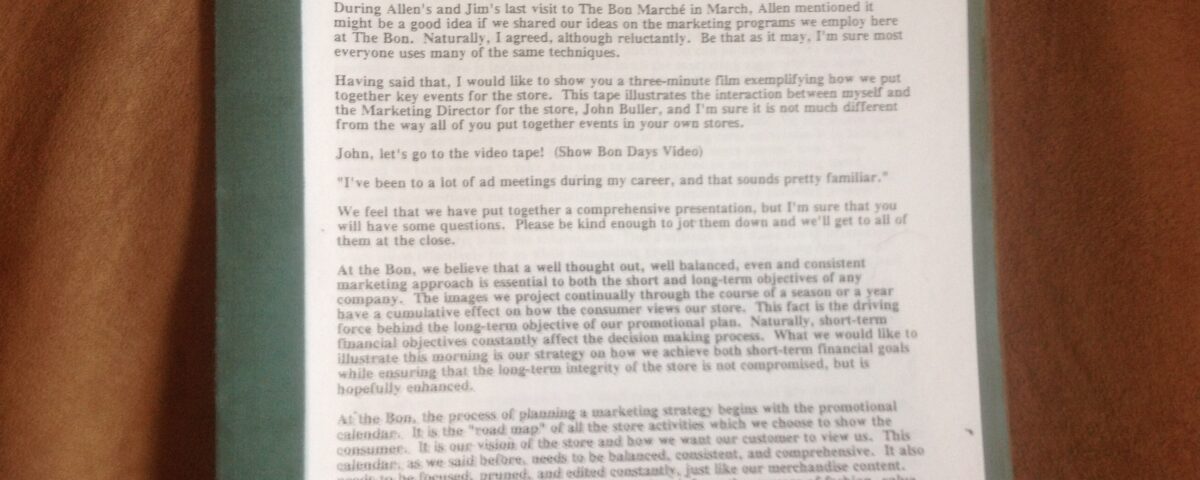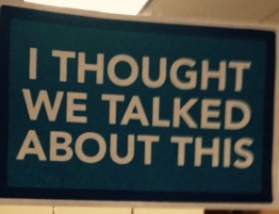
“THERE IS NO FINISH LINE” The Bon Marche `1995′
January 18, 2012Van’s Shoes [Case Study The Proposal] 1996
January 18, 2012The Split Culture
For years, major businesses ran on policies and procedures that suggested a strong priority be placed on consistency. Both the customer and the employee were managed with standards and procedures that did not vary with time or transaction.
Management’s task was defining these standards and then, in turn, fmding new standards that helped to improve the overall operation incrementally. The goal has always been to seek consistent and incremental improvement year in and year out.
Department stores, inclusive of The Bon Marche, find themselves in a peculiar position and difficult time in their history. They are confronted with massive ainounts of competition due to the increase of retail square footage, particularly in the discount portion of the business. The traditional differentiators of quality assortments of branded merchandise only available at the local deparhnent store have deteriorated as brands broaden their distribution.
The consumer has also been changing. In most cases, the buying chores were handled by the woman. Now there are two consmners doing the buying due to the sharing of chores in the duel-income family and time has become very important.
Shopping has given way to planned buying. The consumer has also aged and become less fashion-oriented, focusing more on how the wardrobe needs to be developed. With casual wear becoming acceptable at most work establislunents, there is also a fundainental shift in the consmner’s attitudes toward clothing.
Today’s consumer is in the process of re-defining how American retail will look, act, merchandise, and price in the very near future.
Deparhnent stores have been able to afford higher expense structures and consistent merchandise policies because they provided a variety of products under the saine roof, even though many of the individual fainilies of business margins did not support these expense structures. Product differentiation was the reason. As long as the consmner believed in brands, and brands had limited distribution, then department stores could be department stores.
As the consumer changes and brands become available almost everywhere, the question becomes:
What do department stores do now?
I believe the answer lies in the concept of splitting the culture. No longer will there be one policy and procedure as the standard for all parts of the operation. A careful analysis of the market, product, competition, enviromnent, customer motivation, and technical requirements will be needed for each part of the operation, and different standards and procedures will be adopted.
Take the marking of goods as an example. Up until the last few years, all products were fonneled through the distribution center, counted against the order and the packing slip, marked with a ticket, and distributed to the stores. Today, some merchandise is marked, some is not. Some merchandise is sent to the local distribution center, some is sent to a regional distribution center, and some is sent
straight to the stores. We no longer have one policy and procedure that reflects how this operation functions.
I contend, the most significant issue for department stores, and The Bon Marche, will be the ability to clearly define distinct policies and procedures; to have the associates and customers understand how each works; and, to do this without disn1pting the traditional consumer relationship. The potential confusion of the customer may be too much to bear. The value gained from the expense reduction is not worth the process.
The challenge of department store management is no different today than it has been. Our job is to define policies and procedures that facilitate the execution of the best possible expense structure, fmd ways for employees and customers to understand the policies and procedures, and create the best possible enviromnent to ensure acceptance of these new ways of doing business without disrupting business growth.
The following are some of the areas where split culture might evolve.
- Buying vs. Shopping:
One vital element of the future of retail is the consmner attitude toward shopping versus buying. Traditional department stores have been shopping environments. The key merchant weapon has been merchandising (creating excitement around merchandise) to impact the movement of goods. A quality choice in visual merchandising created sales and the art was similar to “ice fishing.” The customer would come in and it was our job to create excitement. The premise was that the customer shopped two or three times a month and creating visual excitement was the answer.
Today, the increase in retail space has been the front check-out, shelf-stock merchandisers (Fred Meyer, Target, Wal-Mart). These businesses rely on the consmner that has come in to buy and hopes, that while they are in the store, they will also shop. Department stores rely on shopping for 75% of their merchandising style while these merchandisers rely on the buying trip for
their merchandising philosophy. The department store needs to look at each fmnily of business and detennine the buying/shopping equation. For exmnple, the hosiery department is primarily a buying experience while special
occasion dresses remain a shopping experience. All factors of the business will be affected by these definitions.
- Teclmical Products vs. Non-Technical Products:
The mnount of technical information required or needed to be understood in order for a consumer to purchase will have a significant impact on the amount of and style of signing, customer service, and teclmical infonnation that will be needed to help the consmner purchase the product.
Joli n, does this state what you want to say?
The technical infonnation needed to purchase a product will significantly impact the consmner. Signing and customer service will be needed to help the consmner purchase the product.
- Pricing Strategies:
Historically, the Bon has been an aggressive high/low merchandiser. Over the last 20 years, several efforts have been made to establish an “every day low price” value statement in selected inventory. In most cases, the effort failed. Either the every day price was too high or the item was not right. I believe the consumer has defined a group of products, that I will call commodity products, that they have a general understanding as to their value. The consmner also understands brand value versus non-branded value. We will need to start addressing these connnodities as being every day value since these are items that the consmner comes to our stores to buy. We must be able to blend every day pricing to a high/low promotional beat.
A second issue is understanding pricing from a high/low promotional beat and the affect on our credibility. Since most of the advertised classifications are POS’d more than twice per season, we must define policies that help our associates and customers. For basic items, our associates manage our pricing relationship to our customers. The split culture exists between home products and soft products. We must become clearer as to what the nlles are.
- Clearance Strategy:
Each divisional has an opinion as to how to manage their clearance. We have had a series of clearance strategies in the soft portion of the business over the last five years. As a result, the stores and our customers do not understand what we are doing. We must define the clearance strategy by family of business
9. Advertising:
We have always had a mixed culture in advertising. We nm high/low promotions along with new product launches. We have niche promotions as well as all-store promotions. For the last four years, we have continued to build major store wide promotions. We now need to reposition key brands and merchandising areas with quality niche marketing strategies.
10. Customer Policies:
As a result of new technology and pressure on all expense lines, we will need to develop great clarity as to how to apply the subtle changes in these n1les. An example is, of course, returns. In essence, we have a different policy for a person who uses our charge card versus someone who does not. As we looked at third party cards, we found that a significant portion of these customers had shoppyd with us a number of times. So, how do we treat them? We need to be very careful we do not manage the customer exception by creating policies that negatively impact our good customers, no matter
how they pay.
Conclusion:
This docmnent is about managing our change process and defining what I believe will be the most significant issue for the next one to two years:
How to manage an organization that has been run on a single policy and procedu re basis to one that will split its cultu re by the natu re of the prod ucts, service, pricing, and function required to be competitive in the retail marketplace in the coming yea rs.
In each area of the business, we must create a frame work for our employees. We need to get them involved in the process of re-defming to assure our clarity as to what we are doing and how we expect to go forward. Failure to execute will create confusion in our associate’s attitudes and behaviors and, in turn, will affect our attitudes and habits. In the end, our growth and market position will detennine the success of our efforts.
sp!itcul.cb l0/9/96





